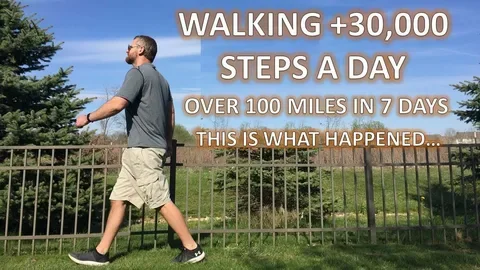Walking is a simple yet powerful way to stay fit, but have you ever wondered how long it takes to walk 7 miles? Understanding your walking pace and the factors that influence it can help you better plan your walks and achieve your fitness goals. In this extended guide, we’ll cover everything you need to know about walking 7 miles, including:
- How long it takes based on different paces.
- Factors that impact walking time, like terrain and weather.
- Practical tips to help you walk more efficiently.
Whether you’re a fitness enthusiast tracking your progress or just curious about how long your next walk will take, this guide will provide valuable insights to help you optimize your walking routine.
Section 1: Understanding Walking Pace
What is Walking Pace?
Walking pace refers to the speed at which you walk, usually measured in miles per hour (mph) or minutes per mile. Understanding your walking pace is crucial because it directly affects how long it will take to cover a specific distance, such as 7 miles. For example:
- Slow Pace: About 2.5 to 3.0 mph.
- Moderate Pace: Around 3.5 to 4.0 mph.
- Brisk Pace: Typically 4.5 to 5.0 mph.
Knowing your pace helps in planning your walks and setting realistic goals. For instance, if you walk at a moderate pace of 3.5 mph, it will take you approximately 2 hours to walk 7 miles.
Average Walking Speeds
The average walking speed can vary based on factors like fitness level, terrain, and individual health. Here’s a breakdown:
- Casual Walkers: Around 2.5 to 3.0 mph. This pace is often comfortable for those who are new to walking or prefer a leisurely pace.
- Average Walkers: About 3.5 to 4.0 mph. This speed is common among people who walk regularly and have a decent fitness level.
- Experienced Walkers: 4.5 to 5.0 mph. This pace is typically achieved by those who are more physically active and accustomed to regular walking.
Understanding these speeds helps you estimate how long it will take you to walk 7 miles based on your current pace.
Calculating Walking Time
To calculate the time it takes to walk 7 miles, use this simple formula:
- Time = Distance ÷ Pace
For example, if you walk at 3.5 mph, the calculation would be:
- 7 miles ÷ 3.5 mph = 2 hours
This formula provides a quick way to estimate walking time based on different paces. Adjust your pace to see how it affects your walking duration and plan your walks accordingly.
Section 2: Factors Affecting Walking Time
Terrain and Surface
The type of terrain you walk on significantly impacts your walking time. Here’s how different surfaces affect your pace:
- Flat Terrain: Walking on flat surfaces is generally the easiest and quickest, allowing you to maintain a steady pace.
- Hilly Terrain: Uphill or downhill walking can slow you down or speed you up, respectively. Uphill walking is more challenging and can reduce your pace, while downhill walking might increase it.
- Uneven Terrain: Surfaces like trails or gravel paths can be difficult to navigate, potentially slowing you down due to the need for careful footing.
Weather Conditions
Weather plays a crucial role in determining how long it takes to walk 7 miles. Consider the following:
- Rain: Wet conditions can make surfaces slippery and affect your pace. Walking in the rain may require extra caution and reduce your speed.
- Heat: High temperatures can lead to dehydration and fatigue, slowing your pace. It’s important to stay hydrated and take breaks as needed.
- Cold: Cold weather can also impact your walking speed. Ensure you dress appropriately to stay warm and maintain a comfortable pace.
Physical Fitness and Experience
Your fitness level and walking experience affect how quickly you can walk 7 miles:
- Beginners: New walkers may find it challenging to maintain a faster pace. Start with shorter distances and gradually increase your mileage to build endurance.
- Experienced Walkers: Those with more experience can often maintain a quicker pace due to improved stamina and technique.
Footwear and Gear
The right footwear and gear can enhance your walking experience:
- Footwear: Proper walking shoes provide support and comfort, helping you walk more efficiently and reducing the risk of injury.
- Gear: Lightweight backpacks or gear can affect your speed. Carry only what you need to avoid unnecessary weight that could slow you down.
Section 3: Practical Tips for Walking 7 Miles Efficiently
Training and Preparation
To walk 7 miles efficiently, follow these tips:
- Build Stamina: Gradually increase your walking distance and pace. Start with shorter walks and progressively extend your distance.
- Warm-Up: Perform a warm-up routine to prepare your muscles and joints for the walk. This can include light stretching or a short, brisk walk.
- Cool-Down: After your walk, take time to cool down with gentle stretches to prevent stiffness and promote recovery.
Tracking and Monitoring
Using technology can help you track and improve your walking performance:
- Fitness Apps: Apps like MyFitnessPal or Strava can track your distance, pace, and time. They also offer features to set goals and monitor progress.
- Wearable Gadgets: Devices like pedometers or smartwatches provide real-time data on your walking stats. They can help you stay on track and make adjustments as needed.
Safety and Comfort
Ensure a safe and comfortable walking experience with these tips:
- Hydration: Drink plenty of water before, during, and after your walk. Staying hydrated helps maintain your energy levels and prevents dehydration.
- Nutrition: Eat a balanced meal or snack before your walk to fuel your body. Choose foods that provide sustained energy, like fruits, nuts, and whole grains.
- Weather Preparedness: Dress appropriately for the weather conditions. Wear layers if it’s cold, and use sunscreen or a hat if it’s sunny.
Section 4: Comparisons and Alternatives
Walking vs. Other Forms of Exercise
Comparing walking to other exercises can help you choose the best activity for your goals:
- Walking vs. Running: Running typically burns more calories per mile compared to walking but may be harder on the joints. Walking is a low-impact alternative that can be easier on the body.
- Walking vs. Biking: Biking can cover longer distances more quickly but requires a bike and is not weight-bearing. Walking offers weight-bearing benefits and is accessible without special equipment.
- Walking vs. Swimming: Swimming provides a full-body workout and is easy on the joints but requires access to a pool. Walking is a more accessible form of exercise that can be done almost anywhere.
Case Studies and Examples
Real-life examples can illustrate different walking experiences:
- Charity Walks: Participants in charity walks often cover distances of 5 to 10 miles. They train specifically for these events, which can provide insights into walking long distances.
- Daily Walkers: Individuals who walk daily for fitness or transportation can offer valuable insights into maintaining a consistent walking routine and achieving personal goals.
Section 5: Frequently Asked Questions (FAQs)
How long does it take to walk 7 miles at a slow pace?
At a slow pace of about 2.5 mph, it takes approximately 2 hours and 48 minutes to walk 7 miles. This pace is suitable for beginners or those enjoying a leisurely walk.
What’s the average time for a moderate pace?
Walking at a moderate pace of 3.5 mph takes about 2 hours to cover 7 miles. This pace is common among regular walkers and provides a good balance of speed and endurance.
How can I speed up my walking time?
To increase your walking speed, try the following:
- Incorporate Interval Training: Alternate between faster and slower walking intervals.
- Improve Fitness: Regularly exercise to build stamina and strength.
- Optimize Technique: Focus on proper walking form and technique to enhance efficiency.
What are common mistakes to avoid when walking long distances?
Avoid these common mistakes:
- Skipping Warm-Ups: Always warm up to prepare your muscles and joints.
- Neglecting Hydration: Drink water regularly to stay hydrated.
- Wearing Inappropriate Shoes: Choose comfortable, supportive footwear to prevent injuries.
Conclusion
Walking 7 miles can be a rewarding and effective form of exercise, provided you understand the factors affecting your walking time. By considering your pace, terrain, and personal fitness, you can better plan your walks and set achievable goals. Use the tips and insights from this guide to optimize your walking routine and enjoy the benefits of a healthier, more active lifestyle.
Additional Resources
- Links to Fitness Apps and Gear: MyFitnessPal, Strava
- Recommended Reading or Further Guides on Walking and Fitness: Check out resources on walking techniques and fitness planning.

Justin Taylor, a sports aficionado, brings unmatched energy and expertise to SpoortsUp.com. Known for his sharp commentary and insightful predictions, Justin’s writing resonates with fans across the globe. His unique perspective on the sports world keeps readers both informed and entertained.











